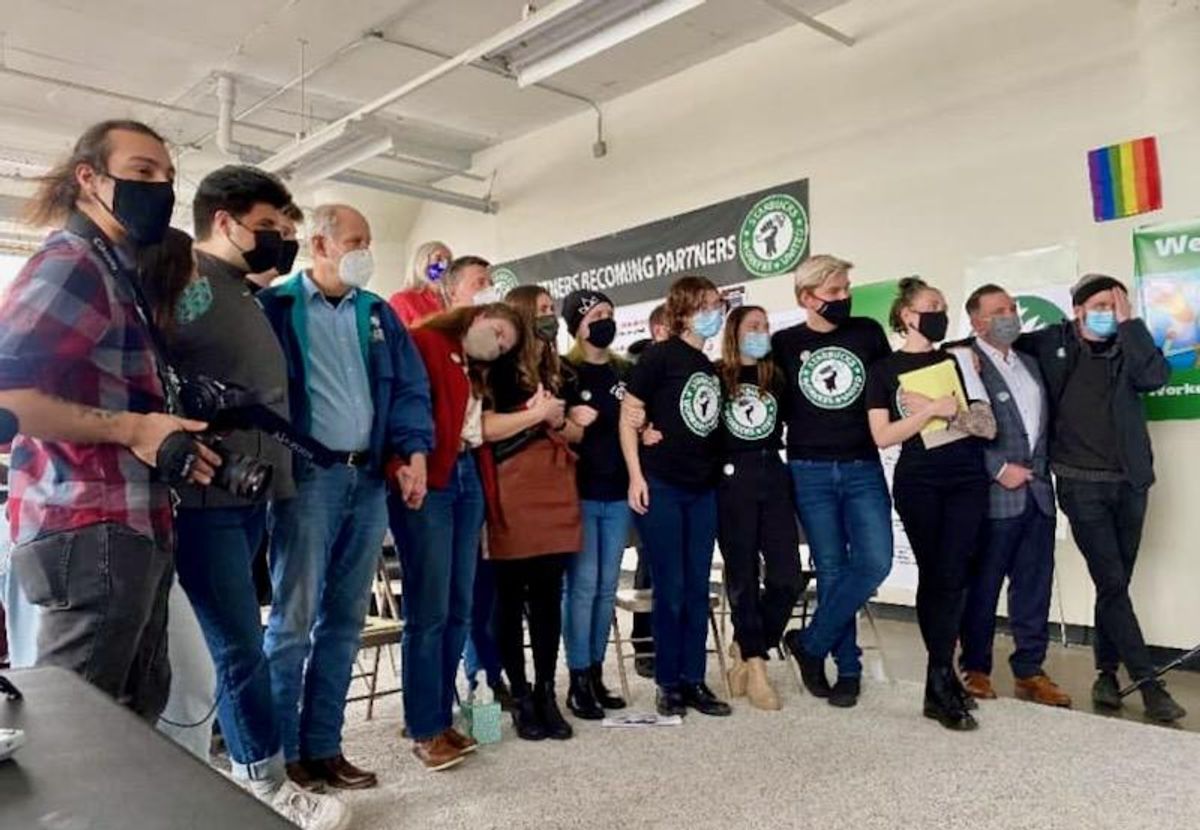Agence France-Presse
October 13, 2022

Starbucks workers, including Will Westlake (4R), in December 2021 as the first cafes voted to unionize(AFP)
Recent unionization drives at Starbucks and Amazon have lifted morale in the US labor movement, but organizers have yet to transform election victories into material change.
Moreover, some union backers such as Will Westlake have paid a price for their activism.
Formerly a Starbucks barista in Buffalo, New York, where the initial union votes took place in December 2021, Westlake was fired earlier this month -- ostensibly for not removing a suicide prevention badge from his apron, which he has viewed as an expression of his solidarity with the movement.
But Westlake thinks his firing was payback for his union activism.
"I was number 123" on the list of Starbucks employees to lose their jobs as the campaign has spread to some 250 cafes nationwide, said Westlake.
Starbucks declined to comment on allegations from Starbucks Workers United that the company fired workers for union activism.
But such reprisals at US companies are "pretty routine in this country," said Ruth Milkman, a sociologist at CUNY in New York.
Young activists
Milkman counts herself among the experts in labor relations who have been surprised at the spread of the union drives to a growing slate of corporations, including Apple, REI, Chipotle and Trader Joe's -- companies that union organizers have not in the past viewed as fertile to their efforts.
"This was kind of a different moment," said Milkman of a period defined by a labor shortage, the pandemic and "a young labor force frustrated by their limited labor market options."
US officials have seen a 53 percent jump in the number of union elections over the last year, according to the National Labor Relations Board.
But that increase takes place against the backdrop of a longtime decline in organized labor since the 1980s, with fewer than 10 percent of private-sector employees now unionized.
While union backers have won some high-profile election victories over the last year, in many cases, the successful votes have taken place at small establishments, such as an individual Starbucks cafe.
What's more, "winning the election is actually the easy part," said Cedric de Leon, a sociologist at the University of Massachusetts at Amherst.
"The hard part is to negotiate the contract," he said. "And there is nothing the government can really do to force the employers to negotiate in good faith."
While two Starbucks cafes in Buffalo voted to unionize last December, the first meeting with management on the contract will take place only this month.
The outlook is even murkier at the Staten Island, New York warehouse that in April became the first Amazon site in the United States to unionize.
But Amazon is contesting the vote, alleging improprieties.
Commenting on a union election now taking place at an upstate New York warehouse, an Amazon spokesman said this week that the company will continue to fight the Staten Island election outcome because "we don't believe it represents what the majority of our team wants."
Culture of intimidation
Under the Biden administration, the NLRB has for its part cracked down on some anti-union conduct by big corporations, as with a complaint earlier this month against Apple after the company prevented the distribution of union fliers in a break room.
In August, a US judge ordered Starbucks to reinstate seven employees that the NLRB found were unlawfully fired by the coffee giant.
Such moves by companies represent an effort to instill in workers "a culture of fear and intimidation," said de Leon, noting that support from President Joe Biden and other political leaders will not be enough to make real change.
But "250 Starbucks going out on a nationwide strike, that could be decisive," he said.
The recent wave of union campaigns has come amid a tight labor market in a period of elevated consumer demand. A recession would alter some of those dynamics, although de Leon notes that previous economically weak periods such as the 1930s and 1970s have boosted unions.
Westlake said he is determined to hold companies like Starbucks to account.
"They are hoping that the public won't care enough and that in two or three years, they will be able to fire all the union leaders and crush the union," said Westlake, who has filed a complaint with the NLRB over his dismissal.
© Agence France-Presse

















